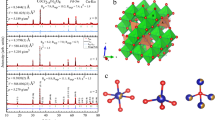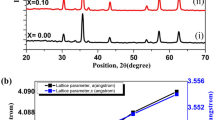Abstract
Here, we demonstrate the existence of magnetic ordering and sliding ferroelectricity in two-dimensional CoH2SeO4 multilayers. The experimental result reveals the antiferromagnetic order in powder sample, and first-principles calculation indicates the antiferromagnetic ground state with TN≈75 K in CoH2SeO4 single layer. The sliding ferroelectricity with an asymmetric triplet potential well is theoretically predicted and experimentally confirmed by 180°-piezoelectric hysteresis loops, switchable domains and second harmonic generation signals in CoH2SeO4 multilayers. The vertically stacked ferroelectric capacitor shows both polarization and capacitance hysteresis loops. A ferroelectric transition temperature of ~370 K is obtained from the temperature-dependent dielectricity. The emergence of sliding ferroelectricity and anti-ferromagnetism points out a new route for obtaining low-dimensional multiferroic materials.

摘要
本文通过第一性原理计算和实验表征证明了二维CoH2SeO4薄膜的磁有序和滑移铁电性. 首先, 实验结果证实了粉末CoH2SeO4样品的反铁磁序. 同时, 第一性原理计算表明单层CoH2SeO4具有反铁磁(AFM-I)基态(TN≈75 K), 且预测了二维CoH2SeO4薄膜具有以不对称的三重势阱态为特征的滑移铁电性, 并在实验中测得了180°压电滞回线、 可反转铁电畴和二次谐波信号. 此外, 在基于二维CoH2SeO4薄膜的电容器中获得铁电材料所特有的电滞回线和蝴蝶状的电容曲线. 介电温谱测试表明二维CoH2SeO4薄膜的铁电转变温度约为370 K. CoH2SeO4中滑移铁电性和反铁磁性的出现为获得低维多铁材料指出了一条新的途径.
Similar content being viewed by others
References
Spaldin NA, Ramesh R. Advances in magnetoelectric multiferroics. Nat Mater, 2019, 18: 203–212
Nan CW, Liu JM. Multiferroics: a beautiful but challenging multi-polar world. Natl Sci Rev, 2019, 6: 620
Novoselov KS. Discovery of 2D van der Waals layered MoSi2N4 family. Natl Sci Rev, 2020, 7: 1842–1844
Chang K, Liu J, Lin H, et al. Discovery of robust in-plane ferroelectricity in atomic-thick SnTe. Science, 2016, 353: 274–278
Zhou Y, Wu D, Zhu Y, et al. Out-of-plane piezoelectricity and ferroelectricity in layered α-In2Se3 nanoflakes. Nano Lett, 2017, 17: 5508–5513
Huang B, Clark G, Navarro-Moratalla E, et al. Layer-dependent ferromagnetism in a van der Waals crystal down to the monolayer limit. Nature, 2017, 546: 270–273
Deng Y, Yu Y, Song Y, et al. Gate-tunable room-temperature ferromagnetism in two-dimensional Fe3GeTe2. Nature, 2018, 563: 94–99
Liu C, Gao R, Cheng X, et al. First-principles study of ferroelectricity, antiferroelectricity, and ferroelasticity in two-dimensional γ-AlOOH. Phys Rev B, 2023, 107: L121402
Yang TH, Liang BW, Hu HC, et al. Ferroelectric transistors based on shear-transformation-mediated rhombohedral-stacked molybdenum disulfide. Nat Electron, 2023, 7: 29–38
Chandrasekaran A, Mishra A, Singh AK. Ferroelectricity, anti-ferroelectricity, and ultrathin 2D electron/hole gas in multifunctional monolayer MXene. Nano Lett, 2017, 17: 3290–3296
Li L, Wu M. Binary compound bilayer and multilayer with vertical polarizations: two-dimensional ferroelectrics, multiferroics, and nano-generators. ACS Nano, 2017, 11: 6382–6388
Fei Z, Zhao W, Palomaki TA, et al. Ferroelectric switching of a two-dimensional metal. Nature, 2018, 560: 336–339
Yasuda K, Wang X, Watanabe K, et al. Stacking-engineered ferroelectricity in bilayer boron nitride. Science, 2021, 372: 1458–1462
Stern MV, Waschitz Y, Cao W, et al. Interfacial ferroelectricity by van der Waals sliding. Science, 2021, 372: 1462–1466
Wan Y, Hu T, Mao X, et al. Room-temperature ferroelectricity in 1T’-ReS2 multilayers. Phys Rev Lett, 2022, 128: 067601
Wang X, Yasuda K, Zhang Y, et al. Interfacial ferroelectricity in rhombohedral-stacked bilayer transition metal dichalcogenides. Nat Nanotechnol, 2022, 17: 367–371
Miao LP, Ding N, Wang N, et al. Direct observation of geometric and sliding ferroelectricity in an amphidynamic crystal. Nat Mater, 2022, 21: 1158–1164
Wu M, Li J. Sliding ferroelectricity in 2D van der Waals materials: related physics and future opportunities. Proc Natl Acad Sci USA, 2021, 118: e2115703118
Liu X, Pyatakov AP, Ren W. Magnetoelectric coupling in multiferroic bilayer VS2. Phys Rev Lett, 2020, 125: 247601
Yu B, Shen Y, Yang S, et al. Preparation and multiferroicity of a novel two-dimensional material NiH2SeO4. J Mater Chem C, 2020, 8: 14812–14818
Jiang Y, Song Y, Pan Z, et al. Rapid amorphization in metastable CoSeO3-H2O nanosheets for ultrafast lithiation kinetics. ACS Nano, 2018, 12: 5011–5020
Kresse G, Furthmüller J. Efficient iterative schemes for ab initio total-energy calculations using a plane-wave basis set. Phys Rev B, 1996, 54: 11169–11186
Kresse G, Furthmüller J. Efficiency of ab-initio total energy calculations for metals and semiconductors using a plane-wave basis set. Comput Mater Sci, 1996, 6: 15–50
Perdew JP, Burke K, Ernzerhof M. Generalized gradient approximation made simple. Phys Rev Lett, 1996, 77: 3865–3868
Dudarev SL, Botton GA, Savrasov SY, et al. Electron-energy-loss spectra and the structural stability of nickel oxide: an LSDA+U study. Phys Rev B, 1998, 57: 1505–1509
Weng DF, Wang ZM, Gao S. Framework-structured weak ferromagnets. Chem Soc Rev, 2011, 40: 3157–3181
Nakamura K, Freeman AJ. Canted ferromagnetism in RuSr2GdCu2O8. Phys Rev B, 2002, 66: 140405
Kalinin SV, Jesse S, Tselev A, et al. The role of electrochemical phenomena in scanning probe microscopy of ferroelectric thin films. ACS Nano, 2011, 5: 5683–5691
Tian BB, Wang JL, Fusil S, et al. Tunnel electroresistance through organic ferroelectrics. Nat Commun, 2016, 7: 11502
Cheema SS, Kwon D, Shanker N, et al. Enhanced ferroelectricity in ultrathin films grown directly on silicon. Nature, 2020, 580: 478–482
Bune AV, Fridkin VM, Ducharme S, et al. Two-dimensional ferroelectric films. Nature, 1998, 391: 874–877
Liu Y, Aziguli H, Zhang B, et al. Ferroelectric polymers exhibiting behaviour reminiscent of a morphotropic phase boundary. Nature, 2018, 562: 96–100
Wang JL, Yuan SZ, Tian L, et al. Transition from relaxor to ferroelectric-like phase in poly(vinylideneflouride-trifluoroethylene-chloroflouroethylene) terpolymer ultrathin films. Appl Phys Lett, 2011, 98: 052906
Acknowledgements
This work was supported by National Key Research and Development Program of China (2021YFA1200700), The National Natural Science Foundation of China (No. 52372120, T2222025 and 62174053), Shanghai Science and Technology Innovation Action Plan (21JC1402000 and 21520714100), and the Fundamental Research Funds for the Central Universities.
Author information
Authors and Affiliations
Contributions
Author contributions Zhu Q, Tian B and Zhao Q conceived and supervised the research. Yu B and Chen L fabricated the devices. Yu B, Chen L, and Liu Y contributed to the electrical and magnetic measurements; Feng G and Wang H carried out materials characterization; Shen Y performed the theoretical calculation. Duan’s supervision. Chu J, Duan C, Liu J, Wan J, and Luo W advised on the experiments and data analysis. Yu B, Chen L, Shen Y, Zhu Q, Tian B and Zhao Q co-wrote the paper. All authors discussed the results and revised the manuscript.
Corresponding authors
Ethics declarations
Conflict of interest The authors declare no conflict of interest.
Additional information
Supplementary information Supporting data are available in the online version of the paper.
Qiuxiang Zhu is an associate professor in the Department of Electronics, East China Normal University. She obtained a BS degree in Material Physics from Nan**g University in 2010 and received a PhD degree in Material Physics and Chemistry from Shanghai Institute of Ceramics, Chinese Academy of Sciences, in 2015. From 2016 to 2018, she worked as postdoc at Centre national de la recherche scientifique (CNRS)/Thales, France. Her research interests include ferroelectric thin films and devices for nonvolatile memory and neuromorphic computing.
Qingbiao Zhao is a professor in School of Chemistry and Environmental Engineering, Wuhan Institute of Technology. He obtained a BS degree in Chemistry from University of Science and Technology of China in 2006 and received a PhD degree in inorganic chemistry in University of South Carolina, USA. His research interests include magnetic oxide materials and functional inorganic materials.
Bobo Tian is a professor in the Department of Electronics, East China Normal University (ECNU) since 2019. He received a double doctoral degree from the University of Paris-Saclay, France, and the University of Chinese Academy of Sciences, China, in 2016. He held the postdoctor position at ECNU from 2016 to 2019. His research interests include memory and brain-like intelligent devices based on ferroelectric materials.
Supporting information
Rights and permissions
About this article
Cite this article
Chen, L., Yu, B., Shen, Y. et al. Room-temperature ferroelectricity in magnetically ordered CoH2SeO4 flakes. Sci. China Mater. 67, 1654–1660 (2024). https://doi.org/10.1007/s40843-023-2795-0
Received:
Accepted:
Published:
Issue Date:
DOI: https://doi.org/10.1007/s40843-023-2795-0




